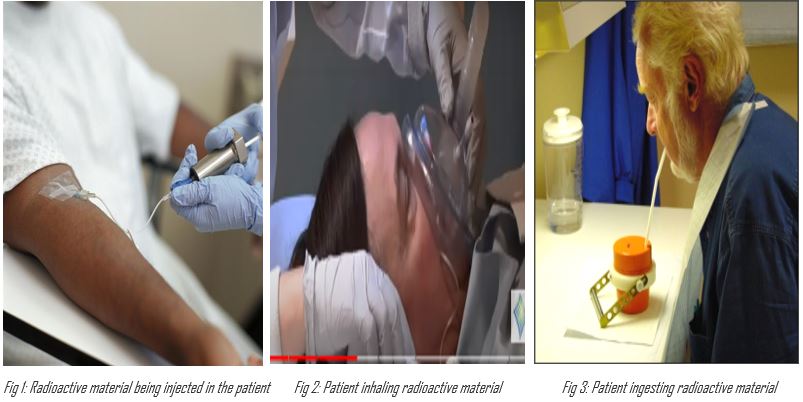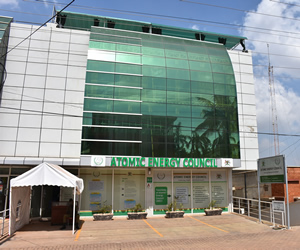Introduction
Nuclear Medicine practice in Uganda started in 1973 under the Department of Physiology, Makerere University Medical School. The unit was formed as a joint venture between Makerere University and Mulago National Referral Hospital. By 2013, the Nuclear Medicine Unit was registering approximately 3000 patients per annum before the total breakdown of the Gamma camera in 2014. In 2016, the Unit embarked on renovations and the facility is non-functional to-date. Patients are referred to outside countries.
What is Nuclear Medicine?
Nuclear Medicine is the specialty that utilizes unsealed radioisotopes in the form of radio-pharmaceuticals to investigate disorders of anatomy, physiology and patho-physiology for diagnosis and/or treatment of diseases.
What is Nuclear Medicine used for?
Nuclear Medicine procedures are used for diagnosis/treatment of many types of cancers, cardiac disease, endocrine & neurological disorders.
How is Nuclear Medicine used to diagnose and treat diseases like cancer?
Nuclear medicine procedures play a vital role in the diagnosis and treatment of diseases. However, these procedures must be conducted by qualified people and in accordance with ethical and professional standards.
A radiotracer through a pill, injection, or gas is administered to a patient. Radiotracers give off gamma rays that can be detected by special cameras. Nuclear medicine experts analyze the images and send a report to the doctor who ordered for the test. Nuclear medicine treatment also uses a small amount of radioactive material (radiopharmaceuticals) which are administered to a patient. Radiopharmaceuticals attach to specific cells and then deliver a high dose of radiation and destroy them.

Are Nuclear Medicines tests and treatments painful?
Nuclear medicine procedures are usually painless. Injections under the skin performed for lymphoscintigraphy scans cause local pain for a few seconds. However, a patient may feel uncomfortable to remain still or to stay in one position. Children also find it difficult to be motionless still during the test.
Does a patient remain Radioactive after under going Nuclear Medicine procedure/scan?
Yes, the patient will be radioactive after a nuclear medicine procedure. However, the patients become non-radioactive after a few days because the radioactive materials of short half lives are used.
Are Nuclear Medicine tests and treatments safe?
Yes, nuclear medicine procedures are safe, provided Nuclear medicine experts carefully select the radiotracer and radiation dose to ensure the minimum radiation exposure and maximum accuracy.
Can any person have a Nuclear Medicine scan or treatment?
Anyone can have a nuclear medicine scan. However, breastfeeding mothers may need to stop breasting for a short time after the test. This is due to the small amount of radioactivity in their bodies which may pass to the breast milk. Also pregnant persons need to notify the nuclear medicine physician for guidance.
How should I prepare for a Nuclear Medicine examination?
- You may wear a gown during the exam or be allowed to wear your own clothing
- Women should always tell their doctor and technologist if they are pregnant or breastfeeding
- Tell the doctor and your exam technologist about any medications you are taking, including vitamins and herbal supplements. List any allergies, recent illnesses, and other medical conditions
- Leave jewelry and accessories at home or remove them prior to the exam. These objects may interfere with the procedure.
- Follow instructions given by medical personnel.
What will I experience during and after a Nuclear Medicine procedure?
- Except for intravenous injections, most nuclear medicine procedures are painless. Reports of significant discomfort or side effects are rare.
- You will feel a slight pin prick when the technologist inserts the needle into your vein for the intravenous line. You may feel a cold sensation moving up your arm during the radiotracer injection. Generally, there are no other side effects
- You may experience nothing. Radiotracers have little or no taste. Inhaling a radiotracer feels no different than breathing the air around you or holding your breath
- With some procedures, the technologist may place a catheter into your bladder that can cause temporary discomfort.
- Discomfort during examination since you may need to remain still or in one position for long periods.
What safety measures should be undertaken for the Protection of Patients and the Public?
- Patients undergoing therapy should not be discharged from the hospital until it is determined to be safe by medical practitioner.
- Patients are exposed to prescribed doses.
- Patient information from previous and similar examinations is taken into consideration to avoid unnecessary additional exposure.
- Administering of radionuclides to pregnant women is avoided unless there are strong clinical indicators.
- Administering of radionuclides to children for diagnostic procedures is carried out only if there is a strong clinical indication.
- Breast feeding of mother undergoing any nuclear medicine procedure should be discontinued until the radiopharmaceutical is considered harmless to the body
What are the Authorisation Requirements for Establishing Nuclear Medicine Facility in Uganda?
- Submit to Council, the structural and architectural drawings of the proposed facility for approval.
- Upon approval, proceed with the construction according to the approved plan. Any modifications should be brought to the attention of Council for approval.
- During the construction, invite Council for verification of each completed phase that has radiation protection and safety concerns.
- Apply to Council for permit to use the radiation premises.
- Apply for all other necessary authorizations to operate a nuclear medicine facility.
Conclusion
Nuclear medicine procedures play a vital role in the diagnosis and treatment of diseases. However, these procedures must be conducted by qualified people and in accordance with ethical and professional standards.





